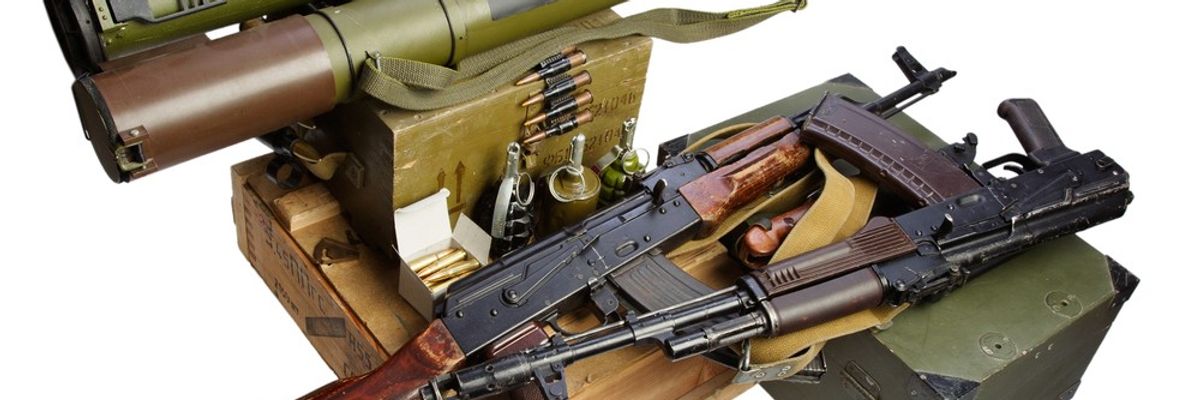After Russia invaded Ukraine on February 24, moving photos of Ukrainian civilians lining up to grab automatic rifles introduced news coverage of the evolving crisis.
Twitter fangirled over the Ukrainian member of Parliament, Lesia Vasylenko, whose father-in-law taught her to use an AK-47 that she now uses to defend her family and her country. Reddit celebrated a young Ukrainian couple who married the day Russia invaded and took up arms together. These photos and stories, meant to rally support for civilians risking their life for home and country, largely ignore the risk of diversion that comes with issuing weapons with little to no oversight.
Over 20 countries have pledged or delivered billions of dollars of military hardware to Ukraine over the past two months, ramping up the risk of diversion, which occurs when weapons, ammunition, and supplies like fuel are redirected from their intended recipients or purpose, usually for illicit activity. The Ukrainian people have the right to self-defense in the face of an invading Russian army according to the United Nations Charter, but flooding weapons into what the Global Organized Crime Index describes as “one of the largest arms trafficking markets in Europe” is a recipe for disaster.
Ukraine struggled with diversion before the Russian invasion, with civilians and soldiers alike funneling weapons into an expansive illicit weapons trafficking network. Although Ukraine ramped up investigations into the theft of military property in 2014, diversion of small and major arms persisted. A Small Arms Survey briefing on illicit arms flows in 2017, for example, found that, of the more than 300,000 small arms that disappeared from Ukraine from 2013 to 2015, only about 13 percent were ever recovered.
The diversion of military-grade weapons is a profitable business in Ukraine, and thousands of hand grenades, rockets, and landmines proliferated from conflict zones around the Donbas region to cities and towns throughout the country. Theft and diversion are not confined to small arms or civilian thieves. In 2019, for example, two Ukrainian soldiers attempted to sell 40 RGD-5 grenades, 15 RPG-22 rockets, and 2,454 firearms cartridges for a mere 75,000 Ukrainian hryvnia (approximately $2,900).
In 2020, a rocket launcher was found in a dumpster in Zhytomyr. That same year, in Odessa, the Security Service of Ukraine discovered 18 RGD-5 grenades, 12 F-1 grenades, and 2 anti-tank mines in a nearby power facility that a service member had stolen from a military base. The servicemen sold at least two grenades before his arrest.
As a report from the Stimson Center notes, the risk of diversion of these war-fighting weapons is even higher for international weapons transfers. In fact, the Global Organized Crime Index found Ukraine’s role as a key link in the global arms trade has only grown since conflicts intensified in eastern Ukraine in recent years. This is a bad omen for the recent influx of international arms transfers. On February 28 alone, for example, Finland pledged to deliver 2,500 assault rifles, 150,000 cartridges for those rifles, and 1,500 single-shot anti-tank weapons; Norway donated up to 2,000 M72 anti-tank weapons; Croatia announced it would send $18 million worth of rifles, machine guns, and protective equipment; and the Italian Parliament is considering sending Stinger surface-to-air missiles, anti-tank weapons, machine guns, and counter-IED systems.
The unfortunate reality is the Ukrainian system, overwhelmed with donations and under massive pressure to deploy them as quickly as possible against the invading Russian army, faces an uphill battle to keep weapons from diverting into the existing illicit arms trade.
Effective end-use monitoring is vital to mitigate the risk of weapons diversion. Jordan Cohen, a Defense and Foreign Policy Studies policy analyst at the Cato Institute, has proposed two strategic changes to improve end-use monitoring for US military support in Ukraine and beyond.
First, the Defense Security Cooperation Agency (DSCA), which authorizes foreign military sales, should implement an end-use monitoring accord with Ukraine. While this is logistically challenging, the Arms Export Control Act already requires the U.S. government to ensure “end-use monitoring of defense articles and defense services” meet agreed-upon standards for foreign military sales. An end-use monitoring accord would also help identify organized crime and diversion networks and would aid Ukrainian authorities in their ongoing enforcement efforts and investigations.
Second, the U.S. State, Defense, and Commerce departments all need additional resources to monitor their weapons transfer programs. The State Department only monitors one percent of total weapons licenses. Of this small percentage, 25 percent of these investigations were “unfavorable,” which means they found discrepancies or recipient foreign governments were unresponsive to inquiries. Investing the necessary resources in understanding where American weapons end up will help mitigate consequences of weapons proliferation through Ukrainian communities.
Effective monitoring will also help protect the United States national security interests and technology from falling into the hands of bad actors, such as those who could use these weapons against us or our allies or to stoke further conflict in Ukraine or elsewhere.
Unfortunately, this essential oversight seems to have fallen by the wayside in the rush to arm civilians against the invading Russian troops. A video shared by Illia Ponomarenko, defense correspondent at The Kyiv Independent, demonstrates the reckless distribution of military-grade weapons.
In the video, men rummage through boxes filled with firearms strewn across a suburban street outside Kyiv’s Obolon. The Ukrainian Armed Forces tweeted that they had “simplified all procedures” as they disseminated these weapons to civilian armies, an emergency measure that could have disastrous short- and long-term effects. Before flooding Ukraine with additional weapons, the U.S. and its NATO allies should consider the risks that they could fuel future conflicts long after the current war has ended.















